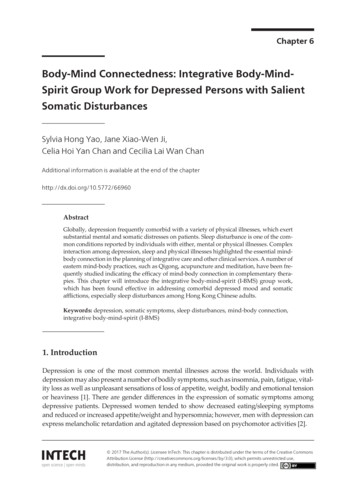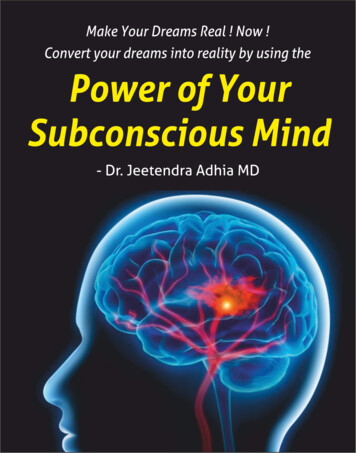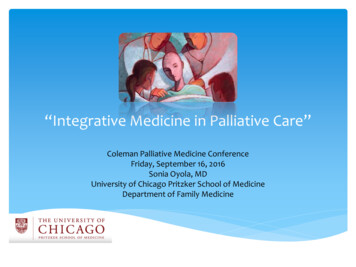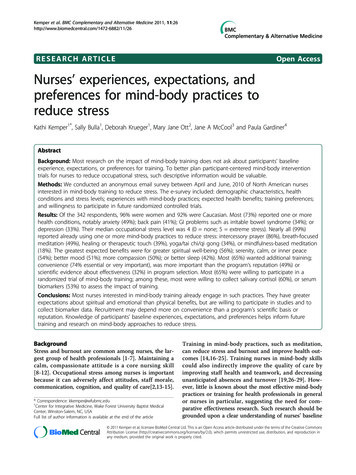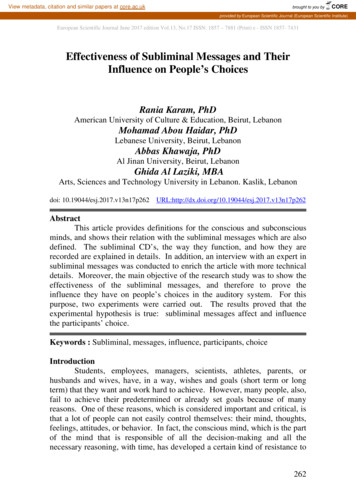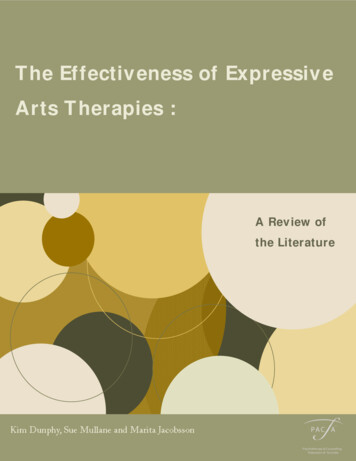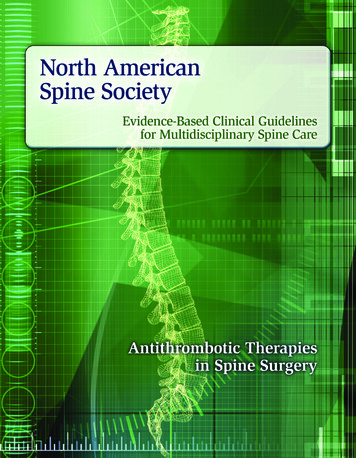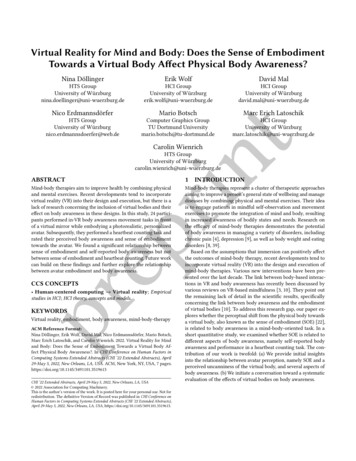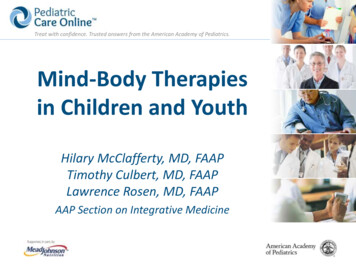
Transcription
Treat with confidence. Trusted answers from the American Academy of Pediatrics.Mind-Body Therapiesin Children and YouthHilary McClafferty, MD, FAAPTimothy Culbert, MD, FAAPLawrence Rosen, MD, FAAPAAP Section on Integrative Medicine
Treat with confidence. Trusted answers from the American Academy of Pediatrics.Overview of Today’s Webinar Introduction to mind-body therapies in youth Mind-body therapies: definitions, clinical applications,training, resourcesooooBiofeedbackYogaMindfulness and mindfulness-based stress reduction (MBSR)Hypnosis and guided imagery Summary/conclusions More information.
Treat with confidence. Trusted answers from the American Academy of Pediatrics.Disclaimer Statements and opinions expressed are those of the authors and notnecessarily those of the American Academy of Pediatrics. Dr. Culbert is a lecturer for HeartMath LLC. Mead Johnson sponsors programs such as this to give healthcareprofessionals access to scientific and educational information provided byexperts. The presenters have complete and independent control over theplanning and content of the presentation, and are not receiving anycompensation from Mead Johnson for this presentation. The presenters’comments and opinions are not necessarily those of Mead Johnson. In theevent that the presentation contains statements about uses of drugs thatare not within the drugs' approved indications, Mead Johnson does notpromote the use of any drug for indications outside the FDA-approvedproduct label.
Treat with confidence. Trusted answers from the American Academy of Pediatrics.Why Are WePresenting This Topic?In our collective experience, wefind that children, teens, andtheir parents are looking fornon-pharmacological options tomanage pain (and relatedsymptoms like anxiety andnausea).Empowering patients with selfregulation (mind-body) skillsimproves outcomes (symptomcontrol and quality of life).The evidence is not perfect,but—we want to get youinterested enough to learn moreabout it!
Treat with confidence. Trusted answers from the American Academy of Pediatrics.Mind-Body Therapies in Children and Youth This webinar is based on a new clinical report. American Academy of Pediatrics (AAP) Section onIntegrative Medicine Vohra, King-Jones, McClafferty, Becker, Bethell, Culbert,Rosen, Sibinga Pediatrics, September 2016, Volume 138 (3), e1896 This clinical report was “.intended to help health careprofessionals guide their patients to non-pharmacologicapproaches to improve concentration, help decreasepain, control discomfort, or ease anxiety.”
Treat with confidence. Trusted answers from the American Academy of Pediatrics.Use of Mind-Body Therapies By Children 2012 National Health Interview Surveyo 3.7% of children ages 4–17 years used mind-body skills.o In teens, ages 13–17 years, females utilized mind-bodyskills more than twice as much as males (5.7% vs 1.7%).o Why use mind-body approaches? Pain-related conditions Emotional/behavioral or mental health issues Reduce stress level/relax, overall health, generalwellness and disease prevention, to feel betteremotionally
Treat with confidence. Trusted answers from the American Academy of Pediatrics.Mind-Body Medicine ApproachMind-body medicine focuses on the interactionsamong the brain, mind, body, and behavior And on the powerful ways in which emotional,mental, social, spiritual, and behavioral factors candirectly affect health.nccih.nih.gov
Treat with confidence. Trusted answers from the American Academy of Pediatrics.Adapted from Cohen MH, Eisenberg DM. Potential physician malpractice liability associated with complementary andintegrative medical therapies. Ann Intern Med. 2002;136(8):596–603.
Treat with confidence. Trusted answers from the American Academy of Pediatrics.BIOFEEDBACKMind-Body Therapies in Children and Youth
Treat with confidence. Trusted answers from the American Academy of Pediatrics.Biofeedback: Definition The use of electronic or electromechanicalequipment to measure and then feedbackinformation about physiological processes to anindividual. This information (visual, kinesthetic,auditory, or multimedia feedback) can then bemodulated by the individual for therapeuticpurposes.
Treat with confidence. Trusted answers from the American Academy of Pediatrics.Common Biofeedback Modalities Muscle (EMG): electrical muscle activity Temperature (TMP): peripheral hand temperature Skin Conductance (EDA): sweat gland activity Heart Rate Variability (HRV): patterns in heart rate Pneumography (PNG): movements with breathing Capnography (CAP): exhaled carbon dioxide Brain Waves (EEG): electrical brain activity Blood Flow (HEG): cranial blood vessel flow
Treat with confidence. Trusted answers from the American Academy of Pediatrics.Biofeedback: Clinical Applications for Youth 1 Headaches (tension and migraine)o Peripheral TMP biofeedbacko Bifrontal EMG biofeedback Asthmao PNG biofeedbacko EMG biofeedbacko HRV biofeedback Rehabilitationo Multichannel EMG biofeedback
Treat with confidence. Trusted answers from the American Academy of Pediatrics.Biofeedback: Clinical Applications for Youth 2 Dysfunctional voiding and encopresiso Pelvic floor surface EMG biofeedbacko Anorectal EMG biofeedbacko Rectal manometric (pressure balloon) biofeedback Attention-deficit/hyperactivity disordero EEG biofeedback For example: suppressing excess theta wave activityand increasing beta wave activity
Treat with confidence. Trusted answers from the American Academy of Pediatrics.Biofeedback: Clinical Applications for Youth 3 Not yet conclusive but up and coming.o Emotional regulation/stress management EDA biofeedback HRV biofeedback EEG biofeedbacko Chronic pain syndromes HRV biofeedbacko Insomnia HRV biofeedbackEDA biofeedbackTMP biofeedbackEEG biofeedback
Treat with confidence. Trusted answers from the American Academy of Pediatrics.Portable Biofeedback Devices for Clients Digital Peripheral Temperatureo Stress Thermometer – www.cliving.org Skin Conductanceo Sweat Gland Activity – thepip.com Brain Wave Activityo EEG Headband – www.choosemuse.com Heart Rate Variabilityo Inner Balance App – www.heartmath.com Biofeedback Gameso Journey to Wild Divine – wilddivine.comJohn Takai. 123RF.com
Treat with confidence. Trusted answers from the American Academy of Pediatrics.Biofeedback: Training and Resources Stens Corporationo Peripheral biofeedback modalitieso EEG biofeedback Biofeedback Certification International Allianceo Certifications Biofeedback Foundation of Europeo Training all modalities HeartMath LLC and HeartMath Instituteo Heart rate variability training and research Association for Applied Psychophysiology and Biofeedbacko Practitioner organization**Most biofeedback use does not require formal training.**
Treat with confidence. Trusted answers from the American Academy of Pediatrics.YOGAMind-Body Therapies in Children and Youth
Sam Gross. The New Yorker Collection/The Cartoon Bank
Treat with confidence. Trusted answers from the American Academy of Pediatrics.Yoga: Definition From the Sanskrit “yuj” union, to join National Center for Complementary and IntegrativeHealth (NCCIH): “Yoga is a mind and body practicewith origins in ancient Indian philosophy. The variousstyles of yoga typically combine physical postures,breathing techniques, and meditation or relaxation.” Therapeutic yoga is designed to improve stresscoping, lessen pain, and improve specific healthconditions.
Treat with confidence. Trusted answers from the American Academy of Pediatrics.Yoga: Epidemiology 2012 National Health Interview Survey (NHIS) 9.5% of US adults (21 million) practiced yoga in 2012 3.1% of US children (1.7 million) practiced yoga in2012 Both up significantly compared with 2007 NHISNational Health Interview Survey (NHIS). Use of Complementary Health Approaches in the U.S. Available at dy/yoga
Treat with confidence. Trusted answers from the American Academy of Pediatrics.Yoga: Evidence Systematic review of controlled trials of pediatrictherapeutic yoga as sole intervention 14 published studies met criteria (through 2013) Positive effects on psychological functioning, especially inchildren coping with emotional, mental, and behavioralhealth problems Educational curricula incorporating stress managementprograms improve academic performance, self-esteem,classroom behaviors, concentration, and emotionalbalance.
Treat with confidence. Trusted answers from the American Academy of Pediatrics.Yoga: Evidence In 4 controlled trials, yoga was demonstrated topositively influence metabolic and hormonal parameters(obesity, polycystic ovary syndrome). No documentation of serious adverse effects in anypublished pediatric yoga trials to date Limitations of reviewed studies include small samplesizes, high attrition rates, lack of evaluator blinding,reliance on self-report measures, and heterogeneity ofintervention and control designs.
Treat with confidence. Trusted answers from the American Academy of Pediatrics.Yoga: Future Directions for Research Well-designed controlled trials of yoga for conditions withstrong stress-modulated components are warranted. Excellent candidate conditions include asthma, irritable bowelsyndrome (IBS), inflammatory bowel diseases, juvenileidiopathic arthritis, and fibromyalgia. Given the preference for yoga in studies of children withchronic pain, coupled with biological plausibility for response,limited potential for adverse effects, and promising pilot data,there is a great need for controlled studies in this population.
Treat with confidence. Trusted answers from the American Academy of Pediatrics.Yoga: Clinical Applications Stress-management, especially in patients withemotional, mental, and behavioral health concerns Educational settings: academic performance, selfesteem, classroom behaviors, concentration; schoolsmay be an ideal setting to bring yoga to aheterogeneous, socioeconomically diverse sample ofchildren. Obesity/metabolic disorders Pain management
Treat with confidence. Trusted answers from the American Academy of Pediatrics.Yoga: Resources NCCIH Yoga – nccih.nih.gov/health/yoga International Association of Yoga Therapists – iayt.org Yoga Alliance – www.yogaalliance.org Kripalu Yoga in the Schools Teacher Training –kripalu.org/kyis-teacher-training Yoga in Schools – yogainschools.org YogaKids Training – yogakids.com/training-and-certification
Treat with confidence. Trusted answers from the American Academy of Pediatrics.MEDITATION & MBSR(Mindfulness-Based Stress Reduction)Mind-Body Therapies in Children and Youth
Pat Byrnes. The New Yorker Collection/The Cartoon Bank
Treat with confidence. Trusted answers from the American Academy of Pediatrics.Meditation and MBSR: Definitions Meditation: The practice of intentional attentiontraining. There are a variety of approaches, includingmindfulness meditation and concentration meditation. MBSR (mindfulness–based stress reduction) refers to anapproach that cultivates purposeful and non-judgmentalawareness of the present moment through cognitive,emotional, and sensory experiences, typically through an8-week program.
Treat with confidence. Trusted answers from the American Academy of Pediatrics.Mindfulness: Definition Paying attention with moment-to-moment awareness On purpose In a particular way Without judgmentAdapted from Kabat-Zinn J. Mindfulness for Beginners: Reclaiming the Present Moment—and Your Life. Boulder, CO: Sounds True, Inc.; 2016.
AttentionIntentionAttitudeAdapted from Shapiro SL, Carlson LE, Astin JA, Freedman B. Mechanisms of mindfulness. J Clin Psychol. 2006;62(3):373–386.
Treat with confidence. Trusted answers from the American Academy of Pediatrics.Mindfulness in Children The brain is more pliable betweeno Birth and 2 yearso 4 and 6 yearso Around puberty Children need an active and sensory-rich approach tomindfulness.Center for Healthy Minds, University of Wisconsin–Madison. centerhealthyminds.org
Treat with confidence. Trusted answers from the American Academy of Pediatrics.Meditation and MBSR: Approaches Mindful breathing Body scan Mindful movement Compassion meditation Love, kindness, gratitude toward self and others Everyday mindfulness, informal practices Mindfulness-Based Stress Reduction Program – JonKabat-Zinn
Treat with confidence. Trusted answers from the American Academy of Pediatrics.Meditation and MBSR: Clinical Applications 1 Respects children’s capacity for coping Recognizes their intelligence Supports their natural ability to pay attention Does not deny what is happening Acknowledges and nurtures their capacity to bepresent in the face of challenging eventsAmerican Academy of Pediatrics Section on Integrative Medicine. Mind-body therapies in children and youth. Pediatrics. 2016;138(3):e20161896.Available at 1896
Treat with confidence. Trusted answers from the American Academy of Pediatrics.Meditation and MBSR: Clinical Applications 2 Mindfulness has shown promise in these areas:ooooooMental healthCoping skillsSelf-regulationImproved self-esteemDecreasing elevated blood pressureReduction in negative school behaviors such asabsenteeism
Treat with confidence. Trusted answers from the American Academy of Pediatrics.Mindful Kids Exercises Parents and other adults should ideally serve as role models. Teach children to apply mindfulness practices duringchallenging situations. Remember to acknowledge what is actually happening in themoment. Daily practice will help to build skills and promote resiliency. Develop an appreciation practice. Send friendly wishes (self, friend, others, the world). Practice compassion for self and others through lovingkindness. Use positive affirmations.Adapted from Bailey ML. Parenting Your Stressed Child. Oakland, CA: New Harbinger Publications, Inc.; 2011.
Treat with confidence. Trusted answers from the American Academy of Pediatrics.Meditation and MBSR: Training and ResourcesCenters of Study Center for Healthy Minds, University of Wisconsin–Madison eing-tips-for-childrenand-their-families Child Mind Institute – childmind.org/article/the-power-of-mindfulness The Chopra Center – ids-about-mindfulness-and-compassion Center for Mindfulness, University of Massachusetts Medical School, JonKabat-Zinn – www.umassmed.edu/cfmApps Stop, Breathe & ThinkTake A ChillSleep Meditations For KidsMindfulness for Children
Treat with confidence. Trusted answers from the American Academy of Pediatrics.Meditation and MBSR: Training and Resources Planting Seeds: Practicing Mindfulness with Children by Thich Nhat Hanh A Still Quiet Place: A Mindfulness Program for Teaching Children andAdolescents to Ease Stress and Difficult Emotions by Amy Saltzman andSaki Santorelli The Mindful Child: How to Help Your Kid Manage Stress and BecomeHappier, Kinder, and More Compassionate by Susan Kaiser Greenland The Mindfulness Revolution: Leading Psychologists, Scientists, Artists, andMeditation Teachers on the Power of Mindfulness in Daily Life edited byBarry Boyce Train Your Mind, Change Your Brain: How a New Science Reveals OurExtraordinary Potential to Transform Ourselves by Sharon Begley Stressed Teens – www.stressedteens.com Center for Healthy Minds – www.centerhealthyminds.org Mindful Schools – www.mindfulschools.org
Treat with confidence. Trusted answers from the American Academy of Pediatrics.HYPNOSIS &GUIDED IMAGERYMind-Body Therapies in Children and Youth
Treat with confidence. Trusted answers from the American Academy of Pediatrics.Hypnosis Misperceptionso Control-all hypnosis is selfhypnosis.o It is not like sleep.o It is not for entertainment. Hypnosis, guided imagery,and visualization are allsimilar.Hermin Utomo. 123RF.com Certification and trainingrequirements vary widely.
Treat with confidence. Trusted answers from the American Academy of Pediatrics.Hypnosis and Guided Imagery: Definitions Hypnosis: When individuals are in a state of hypnosis or whathas been termed “trance,” they enter an altered state ofawareness within which they can intensify attention, decreaseperipheral awareness, and become more receptive to newideas, suggestions, and associations. Guided Imagery: Guided imagery can be described as the useof relaxation and mental visualization to improve moodand/or physical well-being. It often invokes the use of all thesenses and directs one’s imagination in proactive, positiveways.
Treat with confidence. Trusted answers from the American Academy of Pediatrics.Hypnosis and Guided Imagery: Clinical ApplicationsClinical Hypnosis Painoooooo Functional abdominal pain and IBSProcedural painCancerPerioperative painHeadachesVoiding cystourethrogram procedural discomfortAnxietyCancer chemotherapyTics/Tourett’sImmune system supportAsthmaGuided Imagery Functional recurrent abdominal pain Lifestyle change
Treat with confidence. Trusted answers from the American Academy of Pediatrics.Hypnosis and Guided Imagery: Training and Resources National Pediatric Hypnosis Training Instituteo www.nphti.org American Society of Clinical Hypnosiso www.asch.net American Board of Medical Hypnosiso www.abmh.info Academy for Guided Imageryo www.acadgi.com
Treat with confidence. Trusted answers from the American Academy of Pediatrics.SUMMARY & CONCLUSIONSMind-Body Therapies in Children and Youth
Treat with confidence. Trusted answers from the American Academy of Pediatrics.David Sipress. The New Yorker Collection/The Cartoon Bank
Treat with confidence. Trusted answers from the American Academy of Pediatrics.Mind-Body Therapies in Children and Youth:More Skills, Less Pills! The available evidence supporting the use of mind-body skills in childrenand youth varies in quantity and quality, but generally is supportive of mindbody therapies as safe and potentially effective in common and debilitatingconditions, including pain and anxiety. Additional potential benefits for school-age children include improvedconcentration and self-esteem. Mind-body therapies can directly effect physiology, including cardiovascular,nervous, endocrine, gastrointestinal, and immune system functions. Teaching children mind-body skills as a form of self-regulation may havemany long-term benefits. Pediatric healthcare providers are encouraged to facilitate an open dialoguewith their patients/families about the use of complementary therapies andbecome familiar with mind-body therapies as non-pharmacologic options toimprove mood, behavior, and quality of life.
Treat with confidence. Trusted answers from the American Academy of Pediatrics.Steps of Mind–Body Skills Training Discern (mind-body awareness)o Discriminate (objectively) the mind-body differences betweensympathetic nervous system arousal (stress) and parasympatheticnervous system dominant states (relaxation response). Control (mind-body self-regulation)o Learn to modulate (first in a controlled environment) a givenpsychological or physiological function, in a therapeutic direction,consistently. Generalize (transfer the mind-body skill to real life)o Apply this ability to self-regulate mind and body in appropriate lifesituations, as needed, “in the moment.” Restructure (central nervous system) and reset (baseline autonomicnervous system) with regular practiceo Neuroplasticity: long-term changes and benefits with daily practiceo Recognize effects of stress and relaxation as epigenetic modifiers.
Peter C. Vey. The New Yorker Collection/The Cartoon Bank
Treat with confidence. Trusted answers from the American Academy of Pediatrics. But Will Kids Practice Mind-Body Skills? Only if you make it interesting!ooooooBiofeedback gadgetsBooks and CDsMobile appsBubbles and pinwheelsYogaKids/Yoga Calm groupsGamesLorelyn Medina. 123RF.com
Treat with confidence. Trusted answers from the American Academy of Pediatrics.Mind-Body Therapies: Resources Hypnosis and Hypnotherapy With Children, Fourth Edition by Daniel Kohen and Karen Olness Biofeedback: A Practitioner’s Guide, Fourth Edition edited by Mark Schwartz and Frank Andrasik A Still Quiet Place: A Mindfulness Program for Teaching Children and Adolescents to Ease Stressand Difficult Emotions by Amy Saltzman and Saki Santorelli Sitting Still Like A Frog: Mindfulness Exercises for Kids (and Their Parents) by Eline Snel Mindfulness for Beginners by Jon Kabat-Zinn Integrative Pediatrics by Timothy Culbert and Karen Olness Yoga As Medicine: The Yogic Prescription for Health and Healing by Timothy McCall Yoga For Children: 200 Yoga Poses, Breathing Exercises, and Meditations for Healthier, Happier,More Resilient Children by Lisa Flynn Staying Well With Guided Imagery by Belleruth Naparstek Guided Imagery Work With Kids: Essential Practices to Help Them Manage Stress, Reduce Anxiety& Build Self-Esteem by Mellisa Dormoy Transforming Stress for Teens: The HeartMath Solution for Staying Cool Under Pressure by RollinMcCraty, Sarah Moor, Jeff Goelitz, and Stephen Lance
Treat with confidence. Trusted answers from the American Academy of Pediatrics.Mind-Body Skills in Children and Youth:Mobile Applications Mobile appso Breathwork Breathing Zone Breathe 2 Relaxo Meditation Take A Chill Stop, Breathe & Think Smiling Mind
Treat with confidence. Trusted answers from the American Academy of Pediatrics.Mind-Body Skills in Children and Youth:Mobile Applications Mobile appso Yoga The Adventures of Super Stretch Yoga By Teens Kids Yogaverseo Other MeMoves (calming movement and music) Healing Buddies Comfort Kit (symptom management)
Treat with confidence. Trusted answers from the American Academy of Pediatrics.Mind-Body Skills in Children and Youth: Contacts AAP Section on Integrative Medicineo tsalus@aap.org Hilary McClafferty, MD, FAAPo Tucson, Arizona Tim Culbert, MD, FAAPo Minneapolis, Minnesota Larry Rosen, MD, FAAPo Oradell, New Jersey
Treat with confidence. Trusted answers from the American Academy of Pediatrics.Visit Pediatric Care Online today for additional information on this and other topics.pediatriccare.solutions.aap.orgPediatric Care Online is a convenient electronic resource for immediate expert help withvirtually every pediatric clinical information need with must-have resources that areincluded in a comprehensive reference library and time-saving clinical tools.Don’t have a subscription to PCO?Then take advantage of a free trial today!Call Mead Johnson Nutrition at 888/363-2362 or,for more information, go topediatriccare.solutions.aap.org/SS/Free Trial.aspx
Use of Mind-Body Therapies By Children 2012 National Health Interview Survey o 3.7% of children ages 4-17 years used mind-body skills. o In teens, ages 13-17 years, females utilized mind-body skills more than twice as much as males (5.7% vs 1.7%). o Why use mind-body approaches? Pain-related conditions
